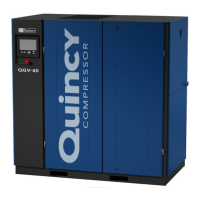Do you have a question about the Quincy Compressor QSI 500 and is the answer not in the manual?
Details the warranty terms and conditions for Quincy compressors and their parts.
Explains the meaning of DANGER, WARNING, CAUTION, and NOTICE symbols used in the manual.
Lists essential safety measures to be observed during operation and maintenance of the compressor.
Provides guidance on ordering genuine Quincy replacement parts to maintain equipment.
Explains the location and importance of the machine's model and serial number for communication.
Provides an overview of the QSI compressors, their construction, and key components.
Details the continuous process of air intake, compression, and discharge in rotary screw compressors.
Describes the path of air through the compressor system from inlet to service connection.
Details how the compressor regulates air delivery based on system demand.
Describes the high air temperature (HAT) sensors and their role in unit protection.
Details on the purpose, sizing, and correct placement of pressure relief valves for system safety.
Checklist of essential steps to perform before the initial startup of the compressor.
Step-by-step guide for safely starting the compressor and monitoring its initial operation.
Procedures for normal and emergency shutdown of the compressor unit.
Identifies and describes the functions of the main components of the compressor's control panel.
Crucial procedures to follow for maximum safety when preparing for maintenance or service.
General safety procedures and precautions for service personnel working on compressors.
Procedure for adjusting the differential pilot valve to set the desired modulation pressure.
Instructions for adjusting the pressure switch for compressor load and unload points.
Identifies probable causes and corrective actions for failures during compressor startup or operation.
Troubleshooting steps for issues related to low air delivery, low/high receiver pressure.
Diagnosing problems related to high temperatures, fluid contamination, and separator clogging.
Addresses problems with inlet valves, unloaders, and other control system components.
Provides recommended maintenance intervals and actions for daily, monthly, and yearly checks.
Final inspection checks for electrical and piping installations before initial compressor startup.
Details the warranty terms and conditions for Quincy compressors and their parts.
Explains the meaning of DANGER, WARNING, CAUTION, and NOTICE symbols used in the manual.
Lists essential safety measures to be observed during operation and maintenance of the compressor.
Provides guidance on ordering genuine Quincy replacement parts to maintain equipment.
Explains the location and importance of the machine's model and serial number for communication.
Provides an overview of the QSI compressors, their construction, and key components.
Details the continuous process of air intake, compression, and discharge in rotary screw compressors.
Describes the path of air through the compressor system from inlet to service connection.
Details how the compressor regulates air delivery based on system demand.
Describes the high air temperature (HAT) sensors and their role in unit protection.
Details on the purpose, sizing, and correct placement of pressure relief valves for system safety.
Checklist of essential steps to perform before the initial startup of the compressor.
Step-by-step guide for safely starting the compressor and monitoring its initial operation.
Procedures for normal and emergency shutdown of the compressor unit.
Identifies and describes the functions of the main components of the compressor's control panel.
Crucial procedures to follow for maximum safety when preparing for maintenance or service.
General safety procedures and precautions for service personnel working on compressors.
Procedure for adjusting the differential pilot valve to set the desired modulation pressure.
Instructions for adjusting the pressure switch for compressor load and unload points.
Identifies probable causes and corrective actions for failures during compressor startup or operation.
Troubleshooting steps for issues related to low air delivery, low/high receiver pressure.
Diagnosing problems related to high temperatures, fluid contamination, and separator clogging.
Addresses problems with inlet valves, unloaders, and other control system components.
Provides recommended maintenance intervals and actions for daily, monthly, and yearly checks.
Final inspection checks for electrical and piping installations before initial compressor startup.
| Brand | Quincy Compressor |
|---|---|
| Model | QSI 500 |
| Category | Air Compressor |
| Language | English |












